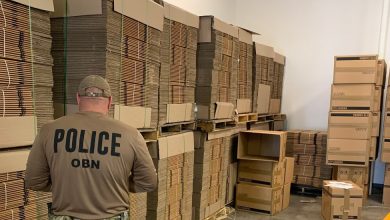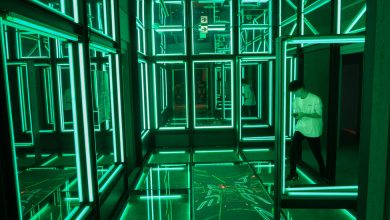Douglas Trumbull, Visual Effects Wizard, Dies at 79

Douglas Trumbull, an audacious visual effects wizard who, in his early 20s, created the memorable hallucinogenic sequence in Stanley Kubrick’s “2001: A Space Odyssey” in which an astronaut hurtled through space, died on Monday at a hospital in Albany, N.Y. He was 79.
His wife, Julia Trumbull, said the cause was complications of mesothelioma.
Mr. Trumbull had been hired by Mr. Kubrick as a $400-a-week artist, and his first job was to create graphics for the 16 screens that surround the “eyes” of HAL 9000, the seemingly omniscient computer that controlled the Discovery One spacecraft.
Then, using a process called slit-scan photography, he conceived the trippy five-minute scene in which the astronaut Dave Bowman (Keir Dullea) soars at hyperspeed in his pod through a phantasmagorical cosmic passageway in the universe.
Mr. Trumbull used a motorized camera that tracked to a slit in a rotatable rectangle of sheet metal, behind which he manipulated illuminated art — wedding his ambitious youthful vision to Mr. Kubrick’s.
“It wasn’t about the normal cinematic dynamics of close-ups and over-the-shoulder shots and reversals and conflicts and plot,” Mr. Trumbull told The New York Times in 2012. Mr. Kubrick, he said, “was trying to go into another world of first-person experience.”
Over the next half-century, Mr. Trumbull became known as one of the film industry’s most innovative visual effects masters. He used old-school tools like mattes and miniatures to enhance science fiction films before digital effects animation became the industry standard.
“He had this ability that I don’t think most people have — to see a final image in his mind and somehow figure out what was needed to get that image on film,” said Gene Kozicki, a visual effects historian and archivist. “Sometimes those images were crazy, like a diaphanous cloud traveling through space heading toward the Enterprise,” the spacecraft in “Star Trek: The Motion Picture.”
For Steven Spielberg’s “Close Encounters of the Third Kind” (1977), Mr. Trumbull’s team injected white tempera paint into an aquarium filled with a mixture of fresh and salt water to create the ominous clouds that announced the coming of the extraterrestrial mother ship.
For Ridley Scott’s “Blade Runner” (1982), Mr. Trumbull used, among many other things, models and images projected onto blimps and buildings to fashion the look of a bleak, dystopian future Los Angeles.
When Philip K. Dick — whose book “Do Androids Dream of Electric Sheep?” was adapted into “Blade Runner” — saw a segment of Mr. Trumbull’s visual effects on a local newscast, he recognized them approvingly as “my own interior world,” he told an interviewer shortly before his death in 1982.
Mr. Trumbull and various colleagues were nominated for Oscars for visual effects for “Close Encounters,” “Blade Runner” and “Star Trek: The Motion Picture (1979), for which he oversaw the docking of the shuttle with the Enterprise and Spock’s spacewalk, a wild excursion (partly through a “plasma energy conduit”) that has obvious visual links to “2001.”
“I thought it would be fun to just get kind of abstract and make it a fantasy dream sequence in a way, not literal,” he told TrekMovie.com in 2019.
In 2012, Mr. Trumbull received the George Sawyer Award from the Academy of Motion Picture Arts and Sciences for his technological contributions to the film industry and the Georges Méliès Award from the Visual Effects Society.
Douglas Hunt Trumbull was born in Los Angeles on April 8, 1942. His mother, Marcia (Hunt) Trumbull, was an artist; his father, Don, worked in visual and special effects, most notably on “The Wizard of Oz,” but had gone to work as an engineer in the aircraft industry by the time Douglas was born.
His father “never mentioned much about ‘The Wizard of Oz,’ except that he had something to do with the lion’s tail, the apple tree and rigging the flying monkeys,” Douglas Trumbull told VFXV, a magazine devoted to visual effects, in 2018.
Growing up, Douglas was a fan of science fiction movies, was fascinated with photography and could build crystal radio sets. After high school, he worked for an electrical contracting firm while studying technical illustration at El Camino College in Torrance, Calif.
He took a job with Graphic Films in Los Angeles, where his paintings of space modules and lunar surfaces appeared in documentaries for NASA and the Air Force. He was hired for “2001” after Mr. Kubrick noticed his work on a 15-minute film, “To the Moon and Beyond,” produced in Cinerama 360 and exhibited during the 1964-65 New York World’s Fair at Flushing Meadows Corona Park in Queens.
After working on “2001,” Mr. Trumbull created space scenes in “Candy” (1968), a comedy based on the novel by Terry Southern and Mason Hoffenberg; provided visual effects for “The Andromeda Strain” (1971), about a team of scientists trying to contain a deadly alien microorganism; and directed his first film, “Silent Running” (1972), in which botanical life has ended on Earth and plants are kept in a greenhouse on a space station by an ecologist played by Bruce Dern.
Although Vincent Canby of The Times called “Silent Running” “simple-minded,” he praised its “beautifully eerie and majestic special effects — particularly it spaceships that looks like horizontal Eiffel Towers attached to gigantic oil tankers.”
Mr. Trumbull resuscitated his father’s film career by hiring him for “Silent Running,” “Close Encounters” and “Star Trek.” The senior Trumbull also worked on George Lucas’s “Star Wars,” but his son was too busy for that one.
Douglas Trumbull’s affinity for vivid visual effects led him to conceive ways to produce films with a format that more closely approached reality. He created Showscan, a cinematic process in which 70-millimeter film is projected at 60 frames per second (35-millimeter projection is usually at 24 frames per second).
He shot part of “Brainstorm” (1983), his second directorial effort, with a Showscan camera. That film — about scientists who devise a system that can record and play a person’s thoughts — is better known for the death of one of its stars, Natalie Wood, during production. Mr. Trumbull fought to complete the film, but it could not be exhibited in Showscan because theaters would not invest in the necessary equipment until all studio films were shot in that format.
But developing the Showscan camera earned Mr. Trumbull, Robert Auguste, Geoffrey Williamson and Edmund DiGiulio the Motion Picture Academy’s Scientific and Engineering Award in 1992.
The experience led him to detour from Hollywood filmmaking and move to the Berkshires, where he worked on projects for the rest of his life. He developed simulator-based attractions like “Back to the Future: The Ride” for Universal Studios Florida, which opened in 1991, and, using Showscan, created “Secrets of the Luxor Pyramid,” a virtual reality experience featuring three films, at the Luxor Hotel and Casino in Las Vegas, in 1993.
In 1994, he signed a deal to bring his simulator-ride technology to Imax. He also served for a time as the company’s vice chairman.
In addition to his wife, Mr. Trumbull is survived by his daughters, Amy Trumbull and Andromeda Stevens; his stepdaughter, Emily Irwin; his stepsons, John Hobart Culleton, Ethan Culleton and John Vidor; nine grandchildren; one great-granddaughter; his sister, Betsy Hardie; his stepsister, Katharine Trumbull Blank; and his half sisters, Kyle Trumbull-Clark and Mimi Erland. His marriage to Cherry Foster ended in divorce; his marriage to Ann Vidor ended with her death.
Mr. Trumbull returned to traditional moviemaking when the director Terrence Malick, a friend, asked him to help on his film “The Tree of Life” (2011). Working as a consultant, Mr. Trumbull helped conjure the kaleidoscopic sequence that depicts the Big Bang and the creation of life on Earth, using chemicals, paint, fluorescent dyes, carbon dioxide, flares, spin dishes, fluid dynamics and high speed photography, he told cinematography.com in 2011.
“It was a freewheeling opportunity to explore, something that I have found extraordinarily hard to get in the movie business,” he said. “We did things like pour milk through a funnel into a narrow trough and shoot it with a high-speed camera and folded lens, lighting it carefully and using a frame rate that would give the right kind of flow characteristics to look cosmic, galactic, huge and epic.”





